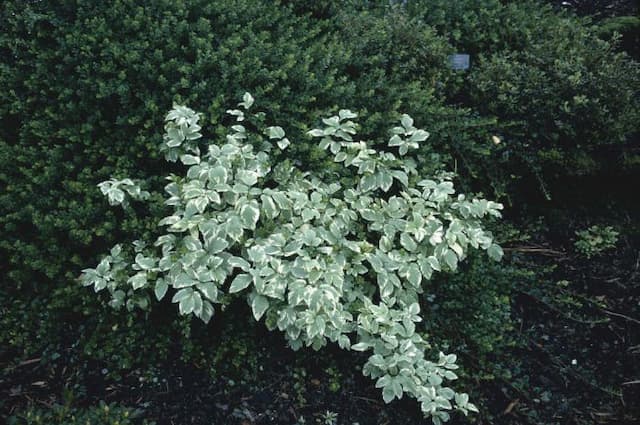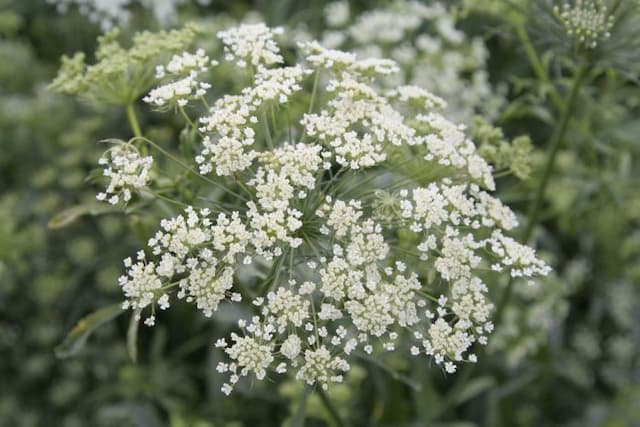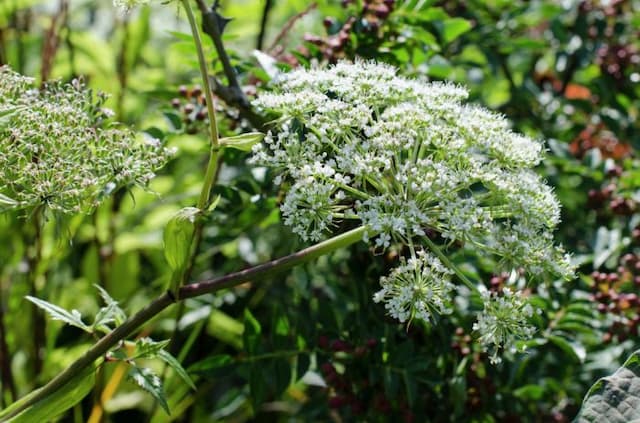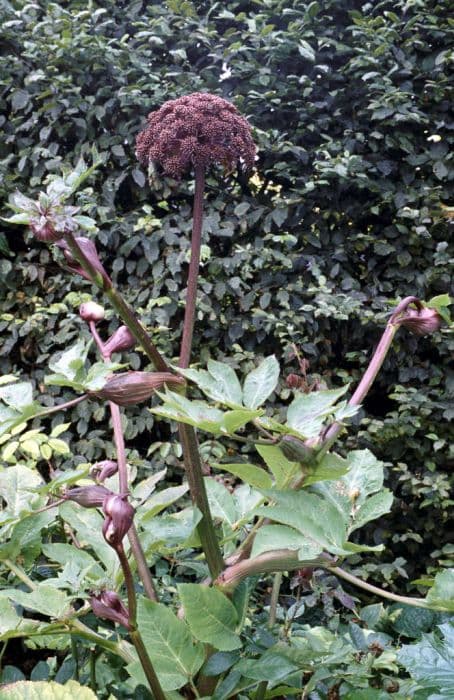Fennel Foeniculum vulgare
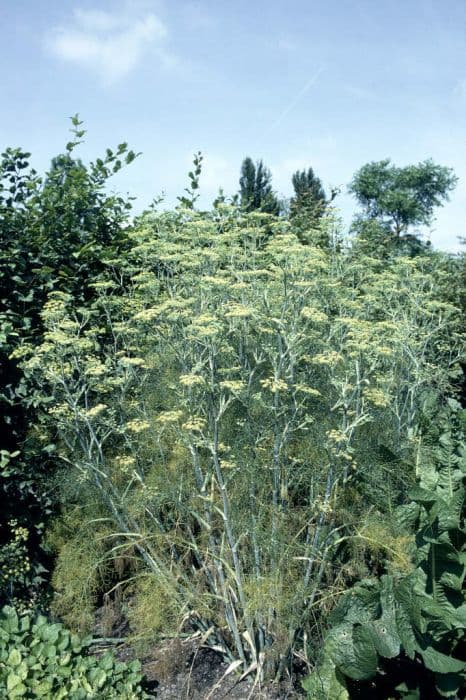
ABOUT
Fennel, known by its common name, is a highly aromatic and flavorful plant characterized by its feathery, almost hair-like foliage that is a vivid green color. The leaves divide into thin, thread-like segments, adding a delicate texture to the plant's appearance. Atop its branching stems, fennel produces yellow flowers grouped together in large, flat-topped clusters, known as umbels, which give way to small, oval seeds. These seeds are usually greenish-brown and ridged, with a potent scent and taste reminiscent of anise. Overall, fennel's unique combination of wispy leaves, striking flowers, and aromatic seeds presents an attractive and sensory-rich profile.
About this plant
 Names
NamesSynonyms
Fennel, Sweet Fennel, Common Fennel, Wild Fennel, Finocchio, Carosella, Florence Fennel.
Common names
Anethum foeniculum, Anethum panmori, Foeniculum capillaceum, Foeniculum divaricatum, Foeniculum dulce, Foeniculum foeniculum, Foeniculum giganteum, Foeniculum officinale, Foeniculum panmorium, Foeniculum piperitum, Foeniculum vulgare var. dulce, Ligusticum foeniculum, Meum foeniculum, Ozodia foeniculacea, Selinum foeniculum, Seseli foeniculum, Seseli piperitum, Tenoria romana.
 Toxicity
ToxicityTo humans
Fennel (Foeniculum vulgare) is typically considered safe for human consumption when used in amounts commonly found in food. However, large doses can be potentially toxic. Fennel seeds contain a compound called estragole, which has been shown to cause tumors in animals when consumed in extremely high doses over an extended period of time. Although there's limited evidence for its carcinogenic effects in humans, excessive consumption could pose health risks, especially for pregnant women.
To pets
Fennel is considered non-toxic to pets and is not listed as a poisonous plant for dogs and cats by the ASPCA. Pets can typically ingest small amounts of fennel without serious risk of illness. However, as with any other food that is not part of the standard diet for pets, fennel might cause mild gastrointestinal upset in some animals if consumed in significant amounts. Symptoms could include vomiting or diarrhea. Always exercise caution and consult with a veterinarian before introducing significant quantities of new foods into your pet's diet.
 Characteristics
CharacteristicsLife cycle
Biennials
Foliage type
Deciduous
Color of leaves
Green
Flower color
Yellow
Height
4-5 feet [1.2-1.5 meter]
Spread
2-3 feet [0.6-0.9 meter]
Plant type
Herb
Hardiness zones
4-9
Native area
Mediterranean
Benefits
 General Benefits
General Benefits- Culinary Uses: Fennel, the common name for Foeniculum vulgare, is widely used in cooking for its anise-flavored leaves, seeds, and bulbs, enhancing the flavors of dishes.
- Aromatic Properties: The plant emits a pleasant fragrance that can be enjoyed in the garden or when used as a fresh herb in culinary preparations.
- Pollinator Attraction: Fennel flowers are known to attract a variety of beneficial insects such as bees and butterflies, which are important for pollination in the garden.
- Companion Planting: Fennel can be used in companion planting to deter certain pests from more vulnerable crops, although it can also be inhibitory to some plants.
- Gardening and Aesthetics: With its tall stature and feathery foliage, fennel adds an ornamental aspect to gardens or as part of landscapes.
- Culinary Versatility: Different parts of the fennel plant, including the seeds, fronds, and bulbs, can be used in a wide range of recipes, offering versatility in the kitchen.
- Herbal Tea Ingredient: The seeds of fennel are often used to make a flavorful and aromatic herbal tea.
- Culinary Garnish: The feathery fronds can be used as a delicate garnish for many dishes, adding both flavor and visual appeal.
- Homemade Seasonings: Dried fennel seeds can be ground to produce homemade spice mixes, suitable for various culinary applications.
- Tradition and Culture: Fennel has a place in traditional ceremonies and cultural practices in some regions around the world.
 Medical Properties
Medical Properties- Carminative - Helps in relieving flatulence.
- Antispasmodic - May alleviate spasms in smooth muscles, such as those in the digestive system.
- Digestive - Often used to promote healthy digestion and reduce discomfort after meals.
- Galactagogue - Traditionally used to enhance milk secretion in breastfeeding women.
- Anti-inflammatory - Can have anti-inflammatory effects which may help with inflammation-related discomfort.
- Antioxidant - Contains compounds that may protect cells from oxidative stress.
- Diuretic - Sometimes used to increase the amount of urine to help in flushing out toxins from the body.
- Antimicrobial - Has been shown to exhibit antimicrobial properties against certain strains of bacteria and fungi.
- Expectorant - May help in relieving congestion of the respiratory tract by loosening phlegm.
- Anethole content - Anethole is the primary component of fennel essential oil; it has been researched for various potential therapeutic effects.
 Air-purifying Qualities
Air-purifying QualitiesThis plant is not specifically known for air purifying qualities.
 Other Uses
Other Uses- Fennel, Foeniculum vulgare, stalks can be used as a natural dye, providing a yellowish or light green tint to fabrics when boiled and used as a mordant.
- The plant can be incorporated into natural cosmetic products such as lotions and soaps for its scent and potential skin-soothing properties.
- Dried fennel leaves and seeds can be employed in potpourri mixtures to add a fresh, anise-like aroma to rooms.
- Fennel seeds can be used as a flavoring agent in natural toothpaste recipes for their fresh, sweet taste.
- The plant's fibrous stalks can be used to create crafts or rustic art pieces, especially in weaving for decorative purposes.
- Fennel can be grown as a companion plant in gardens to attract beneficial insects, such as ladybugs and bees, that help with pollination and pest control.
- Fennel fronds can be used as a natural stuffing for aromatic heat packs or sachets, which can then be used to scent drawers or closets.
- Fennel seeds are sometimes utilized in homemade spice blends or dry rubs for cooking to impart a unique flavor to meats and vegetables.
- The hollow fennel stalks can be cut and used as biodegradable, compostable straws for drinks.
- Fennel flowers, which are small and yellow, can be used as a visually appealing and flavorful garnish on salads and desserts.
Interesting Facts
 Feng Shui
Feng ShuiFennel is not used in Feng Shui practice.
 Zodiac Sign Compitability
Zodiac Sign CompitabilityFennel is not used in astrology practice.
 Plant Symbolism
Plant Symbolism- Strength: Foeniculum vulgare, commonly known as fennel, has been associated with strength and longevity, owing to its hardy nature and long-lasting presence in gardens and wild areas.
- Purification: Throughout history, fennel has been used in various rituals and traditional practices as a means to purify and protect against negative energies and spirits.
- Healing: The medicinal properties of fennel have led to its symbolic meaning of healing, relevant both in ancient herbalism and modern times.
- Athleticism: In ancient Greece, fennel was associated with athletic success and was used in the form of crowns for awarding the winners of competitions. This connection may relate to its supposed ability to promote endurance and strength.
- Knowledge: Fennel has also been tied to knowledge and was thought to help clear the mind and aid in the pursuit of intellectual endeavors.
 Water
WaterFennel requires consistent moisture to thrive, especially during the growing season. Water the plant deeply once or twice a week, ensuring it gets at least one inch of water. The soil should be kept slightly moist, but never soggy, as fennel does not tolerate waterlogged conditions. During periods of drought or high heat, you may need to increase watering frequency. It's better to water in the morning to allow foliage to dry out during the day, reducing the risk of fungal diseases.
 Light
LightFennel thrives in full sun, requiring at least six hours of direct sunlight per day. Locate your fennel in a spot where it can enjoy unobstructed sunlight for the best growth and flavor. However, in regions with extremely hot summers, fennel may benefit from light afternoon shade to prevent bolting.
 Temperature
TemperatureFennel prefers a temperature range between 50 and 70 degrees Fahrenheit for optimal growth. It can survive temperatures down to about 15 degrees Fahrenheit, but growth will be stunted in cold conditions. Hot temperatures over 90 degrees Fahrenheit may cause the plant to bolt and affect the flavor, so providing some shade during the hottest part of the day is advantageous.
 Pruning
PruningPruning fennel is primarily for maintaining shape and encouraging bushier growth. Trim back any overly long or damaged stalks throughout the growing season. After the initial harvest, cut the fennel back to promote a second growth for later harvesting. The best time for major pruning is just after the plant has finished flowering.
 Cleaning
CleaningAs needed
 Soil
SoilFennel prefers well-drained, fertile soil with a pH between 6.0 and 7.0. A good mix can be created using a combination of garden soil, compost, and sand to ensure proper drainage and fertility. Add a balanced, slow-release fertilizer to the mix prior to planting for best results.
 Repotting
RepottingFennel, often grown as an annual, does not commonly require repotting. If started in containers, transplant to the garden before it becomes root-bound. For perennial types, consider dividing every 3 to 4 years to maintain vigor.
 Humidity & Misting
Humidity & MistingFennel is not particularly sensitive to humidity levels and can thrive in the average outdoor humidity. It's more important to provide it with full sun and adequate soil moisture without overwatering.
 Suitable locations
Suitable locationsIndoor
Provide full sun, well-drained soil, and space for growth.
Outdoor
Plant in full sun, space well, and provide fertile, well-drained soil.
Hardiness zone
5-10 USDA
 Life cycle
Life cycleFennel (Foeniculum vulgare) begins its life cycle as a seed, which, when sown in fertile, well-drained soil and given adequate sunlight and water, will germinate. Germination typically occurs in the spring, with the emergence of the seedling, characterized by its feathery, dill-like leaves. It then enters a vegetative growth phase, expanding both foliage and root system, and if conditions are favorable, this herbaceous perennial can develop into a thick, bushy plant within the first season. The maturity phase is marked by the appearance of its characteristic bright yellow umbel flowers, which generally occurs in the plant's second summer. These flowers attract a variety of pollinators, after which they set seed by late summer or fall, and the plant can self-sow if seeds are not harvested. In the last phase of its life cycle, post-reproduction, the above-ground portions of fennel die back with the onset of cold weather, but the plant can regenerate from its robust root system in the following spring.
 Propogation
PropogationPropogation time
Spring to early summer
Foeniculum vulgare, more commonly known as fennel, is most commonly propagated through seeds. The best time to sow fennel seeds is in the spring after the danger of frost has passed. To propagate fennel by seeds, sow them directly into well-drained, fertile soil in a sunny location, planting them at a depth of about 1/4 inch (approximately 6 millimeters). It is advisable to space the seeds about 4 to 18 inches apart (10 to 45 centimeters) to give each plant enough room to grow. Keep the soil moist until germination occurs, which typically takes about 7 to 14 days. Once the seedlings are a few inches tall, thin them out if necessary to prevent overcrowding and to ensure proper development of the plants. Fennel can also be started indoors 4 to 6 weeks before the last expected frost, and then transplanted outside when conditions are suitable.
